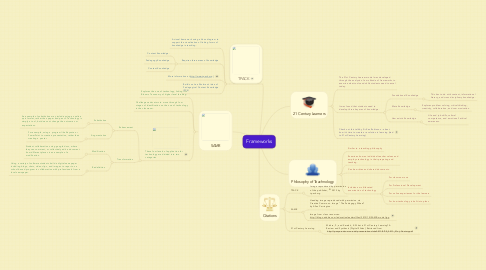
1. TPACK
1.1. A visual framework using a Venn diagram to support the visualization of linking forms of knowledge in teaching.
1.2. Requires three areas of knowledge
1.2.1. Content Knowledge.
1.2.2. Pedagogy Knowledge
1.2.3. Content Knowledge
1.3. More information at http://www.tpack.org/
1.4. Builds on Lee Shulman's idea of Pedagogical Content Knowledge (PCK)
2. SAMR
2.1. Explores the use of technology, linking it to Blooms Taxonomy of higher level thinking.
2.2. Challenges educators to move through four stages of identification on the use of technology in the classroom.
2.3. These four levels of application for technology are divided into two categories
2.3.1. Enhancement
2.3.1.1. Substitution
2.3.1.1.1. An example of substitution may include using an online quiz format, rather than paper and pencil. Technology is simply a tool, but does not change the outcomes or expectations.
2.3.1.2. Augmentation
2.3.1.2.1. For example, using a program like Keynote or PowerPoint to create a presentation, rather than creating a poster.
2.3.2. Transformation
2.3.2.1. Modification
2.3.2.1.1. Student collaboration using google docs, where they can comment, or collectively edit a document from different places is an example of a modification.
2.3.2.2. Redefinition
2.3.2.2.1. Using a variety of software students build a digital newspaper including blogs, chats, video clips, and images to report on a school based program in collaboration with professionals from a local newspaper.
3. 21 Century Learners
3.1. The 21st Century Learner model was developed through the analysis of a multitude of frameworks to examine what tools and skills students need to excel today.
3.2. It was found that students need to develop three key ares of knowledge.
3.2.1. Foundational Knowledge
3.2.1.1. This has to do with content, informational literacy, and cross disciplinary knowledge.
3.2.2. Meta Knowledge
3.2.2.1. Explores problem solving, critical thinking, creativity, collaboration, and communication.
3.2.3. Humanistic Knowledge
3.2.3.1. Life and job skills, cultural competence, and emotional/ ethical awareness.
3.3. Check out this talk by Sir Ken Robinson - about how it's time to create a revolution in learning (tied to 21st Century Learning)
4. Philosophy of Teachnology
4.1. Similar to a teaching philosophy
4.2. Examines how an individual teacher values and employs technology in their preparing and teaching.
4.3. Can be written and shared documents.
4.4. Includes a multifaceted examination of technology
4.4.1. For classroom use
4.4.2. For Professional Development
4.4.3. For online experiences for the learners
4.4.4. For how technology is built into plans
5. Citations
5.1. TPACK
5.1.1. Image reproduced by permission of the publisher, © 2012 by tpack.org
5.2. SAMR
5.2.1. Heading image reproduced with permission via Creative Commons. Image "The Padagogy Wheel" by Allan Carrington.
5.2.2. Image from class resources: http://blogs.adobe.com/educationleaders/files/2012/10/SAMR-model.jpg
5.3. 21st Century Learning
5.3.1. Mishra, P., and Kereluit, K. What is 21st Century Learning? A Review and Synthesis [Digital Slides]. Retrieved from http://punya.educ.msu.edu/presentations/site2011/SITE_2011_21st_Century.pdf
